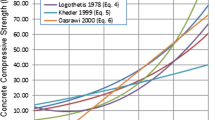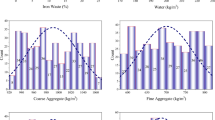Abstract
Destructive tests for evaluating concrete compressive strength are costly and challenging in certain instances. Using a rebound hammer (RH) and ultrasonic pulse velocity (UPV), i.e., non-destructive methods for strength evaluation, proved more beneficial in all senses. However, calibrating the model between non-destructive testing (NDT) and compressive strength is essential for estimating strength. The reliability of this calibration is a crucial task that leads to selecting a minimal number of cores to be taken out (core) from a structure. The present study aims to identify and optimize the on-site reliability model. Extensive data from 275 core samples were obtained from the Construction Diagnostic Centre, Pune (India), which RH and UPV examined. The cores are taken from thirty existing RCC structures built between 1975 and 2005. The Root Mean Square Error (RMSE) and the coefficient of determination (R2) for single method (SM) and combined method (CM) are used to investigate the total number of cores needed for calibration. According to RMSEpred and R2pred, at least 6–8 cores are required to achieve the correct prediction phase with a CM rather than using SM. The CM leads to more reliable results than an SM with the least RMSE and higher R2 values by analyzing 100 iterations for each number of cores (NC). Also, the CM shows more reliable results than the SM in the fitting and prediction phase. As a reasonable number of samples, 9 cores must be considered to converge for an SM, compared to 6–8 cores necessary for CM to estimate the strength precisely.





Similar content being viewed by others
References
Pucinotti R (2013) Assessment of in situ characteristic concrete strength. Constr Build Mater 44:63–73
ACI 228.1R-03 (2003) In-place methods to estimate concrete strength. American Concrete Institute, Michigan
Benyahia KA, Sbartaï ZM, Breysse D, Kenai S, Kenai GM (2017) Analysis of the single and combined non-destructive test approaches for on-site concrete strength assessment: general statements based on a real case study. Case Stud in Constr Mater 6:109–119
Alwash M, Breysse D, Sbartaï ZM (2015) Non-destructive strength evaluation of concrete: analysis of some key factors using synthetic simulations. Constr Build Mater 99:235–245
Pucinotti R (2015) Reinforced concrete structure: non-destructive in situ strength assessment of concrete. Constr Build Mater 75:331–341
Breysse D (2012) Nondestructive evaluation of concrete strength: a historical review and a new perspective by combining NDT methods. Constr Build Mater 33:139–163
Vona M, Nigro D (2015) Evaluation of the predictive ability of the in situ concrete strength through core drilling and its effects on the capacity of the RC columns. Mater Struct 48:1043–1059
Fiore A, Porco F, Uva G, Mezzina M (2013) On the dispersion of data collected by in situ diagnostics of the existing concrete. Constr Build Mater 47:208–217
EN 13791 (2019) Assessment of in-situ compressive strength in structures and precast concrete components, Brussels: CEN.
Cristofaro MT, Viti S, Tanganelli M (2020) New predictive models to evaluate concrete compressive strength using the SonReb method. J Build Eng 27:100962
Breysse D, Martinez-Fernandez JL (2014) Assessing concrete strength with rebound hammer: a review of key issues and ideas for more reliable conclusions. Mater Struct 47:1589–1604
Mujahid A, Sheraz A, Azevedo AR, Markssuel TM, Khan MI, Rafiq W (2022) Experimental and analytical investigation on the confinement behavior of low strength concrete under axial compression. Structures 36:303–313
Raheel A, Mohsin AK, Rayed A, Muhammad FJ, Mujahid A (2023) Promoting the green construction: scientometric review on the mechanical and structural performance of geopolymer concrete. Constr Build Mater 368:130502
Suleman AK, Mohammad AK, Muhammad NA, Mujahid A, Al F, Fahad A (2023) Sustainable alternate binding material for concrete using waste materials: a testing and computational study for the strength evaluation. J Build Eng 80:107932
Guoliang L, Hongzhi Z, Muhammad NA, Athar Z, Ahmed MH, Mujahid A, Muhammad FR (2023) Strength predictive models of cementitious matrix by hybrid intrusion of nano and micro silica: hyper-tuning with ensemble approaches. J Market Res 26:1808–1832
Sohaib N, Jian Y, Xing-Er W, Kaffayatullah K, Muhammad NA, Mohammad FJ, Fadi A, Mujahid A (2023) Estimation of strength, rheological parameters, and impact of raw constituents of alkali-activated mortar using machine learning and shapely additive explanations (SHAP). Constr Build Mater 377:131014
Baoping Z, Yanbing W, Muhammad NA, Bawar I, Kaffayatullah K, Mujahid A, Fadi A (2023) Artificial intelligence-based optimized models for predicting the slump and compressive strength of sustainable alkali-derived concrete. Constr Build Mater 409:134092
EN 12504–1, (2000) Testing concrete in structures-Part 1: cored specimens-taking, examining, and testing in compression, Brussels: CEN
ASTM C42 (2012) Standard test method for obtaining and testing drilled cores and sawed beams of concrete. ASTM International, Philadelphia
Bungey JH, Millard SG, Grantham MG (2006) Testing of concrete in structures, 4th edn. Taylor and Francis, London
Ministry of railways-India, (2009) Guidelines on Non-destructive testing of bridges BS-103, Lucknow: B&S Directorate, India.
RILEM TC 43-CND (1993) Draft recommendation for in situ concrete strength determination by combined non-destructive methods. Mater Struct 26(155):43–49
Kumavat HR, Chandak NR (2021) Experimental investigations on effect of compaction, curing, water to cement ratio, cement type, and temperature variation on the rebound hardness of concrete. KSCE J Civ Eng 25:1857–1864
Liu JC, Sue ML, Kou CH (2009) Estimating the strength of concrete using surface rebound value and design parameters of concrete material. Tamkang J Sci Eng 12(1):1–7
Khan MI, Nasir K, Hashmi SRZ, Yazid MRM, Md NI, Yusoff RWA, Mujahid A, Roman F (2023) Prediction of compressive strength of cementitious grouts for semi-flexible pavement application using machine learning approach. Case Stud Constr Mater 19:e02370
Shcherbakov MV (2013) A survey of forecast error measures. World Appl Sci J 24:171–176
Nobile L (2015) Prediction of concrete compressive strength by combined non-destructive methods. Meccanica 50(2):411–417
Kumavat HR, Chandak NR (2023) Repeatability of concrete rebound hardness using comprehensive statistical analysis. J King Saud Univ-Eng Sci 35(3):167–173
Kumavat HR, Chandak NR, Patil IT (2021) Factors influencing the performance of rebound hammer used for non-destructive testing of concrete members: a review. Case Stud Constr Mater 14(1–12):e00491
Mariam FG, Metwally AE (2013) Implementation of nondestructive combined test methods in prediction of concrete strength in Egypt. Eng Res J 36(2):195–204
Acknowledgements
The authors declare that there is no funding provided for this research from any institution or organization. Authors of the paper would like to express special thanks to Er. Ravi Ranade, MD of Construction Diagnostic Centre, Pune who has provided testing results to assist this research work.
Author information
Authors and Affiliations
Corresponding author
Ethics declarations
Conflict of interest
The authors declare that there is no conflict of interest if there are potential conflicts of interest, we highly encourage each other to identify and declare clearly to avoid any future investigation by the publisher.
Ethical approval
This article does not contain any studies with human participants or animals performed by any of the authors.
Informed consent
For this type of study formal consent is not required.
Rights and permissions
Springer Nature or its licensor (e.g. a society or other partner) holds exclusive rights to this article under a publishing agreement with the author(s) or other rightsholder(s); author self-archiving of the accepted manuscript version of this article is solely governed by the terms of such publishing agreement and applicable law.
About this article
Cite this article
Kumavat, H.R., Chandak, N.R. Statistical analysis for evaluating concrete strength of existing structure using non-destructive and destructive test. Innov. Infrastruct. Solut. 9, 173 (2024). https://doi.org/10.1007/s41062-024-01490-w
Received:
Accepted:
Published:
DOI: https://doi.org/10.1007/s41062-024-01490-w




